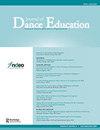Using Student Field Observations in Dance Pedagogy Coursework: Learner and Teacher Perspectives
Q1 Arts and Humanities
引用次数: 0
Abstract
ABSTRACTWhat happens when undergraduate dance pedagogy students observe dance educators’ teaching practices in diverse dance education sectors? Traditional field observation focuses primarily on the teacher, teaching methods, and classroom management. Comparatively, critical field observations examine teacher and learner action equally through rich description of relationships between teacher and student, student and student, and the whole group, including communication patterns and equity, engagement, and pedagogical values and priorities. The authors, a recent undergraduate student and a dance professor, discuss their respective experiences and insights on immersive, experiential learning gained from conducting critical field observations. Discussion also covers informed understanding of pedagogical theory and practice through a social foundations lens. Insights from the critical field observation project are shared from student peers in the dance pedagogy course (n = 18), complementing and expanding the authors’ perspectives in conversation with the diverse range of learning outcomes and deepened classroom-based knowledge.KEYWORDS: Dance pedagogyexperiential learningsocial foundationsteaching methodsfield observations Disclosure StatementNo potential conflict of interest was reported by the authors.Supplementary MaterialSupplemental materials for this article can be accessed online at https://doi.org/10.1080/15290824.2023.2214558.Supplementary MaterialAppendix 1 of this article can be accessed under “Supplemental Material” on the publisher’s website.Notes1. Barr and Risner importantly note, “Today’s dance educators enter classrooms populated by increasingly diverse students in which teachers’ pedagogical knowledge necessitates heightened understandings of race, ethnicity, social class, gender, and sexuality. Uncovering taken-for-granted assumptions, dominant stereotypes, and educational structures that reproduce social inequalities in schools requires teacher preparation in social foundations of education” (Citation2014, 136).2. Various pedagogical frameworks in Module Three of the course include banking method of education (Freire Citation1970), engaged pedagogy and connected teaching (hooks Citation2006), critical feminist dance pedagogies (Shapiro Citation1998; Stinson Citation1998, Citation2005), culturally relevant dance pedagogy (McCarthy-Brown Citation2009), and humanizing dance pedagogy and immersive learning in practice (Risner Citation2021).在舞蹈教学课程中使用学生实地观察:学习者和教师的观点
摘要舞蹈教育学本科学生在观察不同舞蹈教育部门的舞蹈教育者的教学实践时会发生什么?传统的实地观察主要关注教师、教学方法和课堂管理。相比之下,批判性的实地观察通过对教师与学生、学生与学生以及整个群体之间关系的丰富描述,包括沟通模式和公平、参与、教学价值和优先事项,平等地检查教师和学习者的行为。两位作者分别是一名刚毕业的本科生和一名舞蹈教授,他们讨论了各自从进行批判性实地观察中获得的沉浸式体验式学习的经验和见解。讨论还涵盖了通过社会基础镜头对教学理论和实践的知情理解。在舞蹈教育学课程(n = 18)中,来自关键实地观察项目的见解与学生同行分享,在与各种学习成果和深化的课堂知识的对话中补充和扩展了作者的观点。关键词:舞蹈教学;体验式学习;社会基础;教学方法;补充材料本文的补充材料可在https://doi.org/10.1080/15290824.2023.2214558.Supplementary上在线获取。本文的附录1可在出版商网站的“补充材料”下获取。Barr和Risner重要地指出,“今天的舞蹈教育者进入了由越来越多样化的学生组成的教室,教师的教学知识需要提高对种族、民族、社会阶层、性别和性取向的理解。揭露那些在学校中再现社会不平等的想当然的假设、占主导地位的刻板印象和教育结构,需要教师在教育的社会基础方面做好准备”(引文2014,136)。课程模块三的各种教学框架包括银行教育方法(Freire Citation1970)、参与式教学法和关联式教学(hooks Citation2006)、批判女权主义舞蹈教学法(Shapiro Citation1998;Stinson Citation1998, Citation2005),文化相关舞蹈教学法(McCarthy-Brown Citation2009),以及人性化舞蹈教学法和实践中的沉浸式学习(Risner Citation2021)。
本文章由计算机程序翻译,如有差异,请以英文原文为准。
求助全文
约1分钟内获得全文
求助全文
来源期刊

Journal of Dance Education
Arts and Humanities-Visual Arts and Performing Arts
CiteScore
1.80
自引率
0.00%
发文量
47
 求助内容:
求助内容: 应助结果提醒方式:
应助结果提醒方式:


